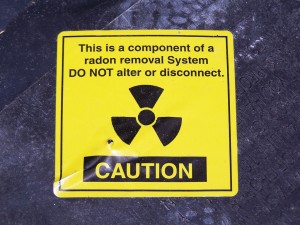Radon is a colorless, odorless, and tasteless radioactive gas that forms naturally. It can seep into any home through cracks in the foundation, walls and floors regardless of location. That means every homeowner should test their home for the presence of radon, but not just the presence – the abundance of it, as well.
 How is Radon Formed?
How is Radon Formed?
Radon forms naturally during the decay of various radioactive elements such as uranium. The affected elements can be found at several different levels in soil and rock, all around the world. As the elements decay they produce the deadly gas radon which moves into the air and upper levels of the ground. It can also seep into ground and surface water, which is yet another way it can enter the home – through a water source.
Many people believe that radon gas, or at least the presence of it is a hoax – a placebo if you will. It is very real, and it is a danger to everyone. It can seep into any home, residence, or business.
Why is Radon so Dangerous?
Long term exposure to radon is the biggest problem, however symptoms do not generally show until its too late. Since radon is the second leading cause of cancer the world over, it’s likely that those exposed to radon for extended periods of time will eventually be plagued by it. Lung cancer has a remarkably high mortality rate, because like radon poisoning there are no short term symptoms. In fact, most of the time when a lung cancer victim has been diagnosed the disease has progressed beyond a curable state.
What’s really sad is that there are 20,000 lung cancer deaths every year in the United States which are directly associated to radon exposure, yet many of them could be prevented.
How to Avoid Radon Exposure?
For the most part, there will always be some level of radon gas inside your residence. However, once the levels are above 4.0pCi/L, the Environmental Protection Agency recommends immediate action. We actually recommend taking action if the levels are above 2.0pCi/L, because even that can be considered a dangerous amount.
The only way to discover the presence of radon, or find out how much exists inside your home is to perform a test. If test results show elevated levels, then you need to have a mitigation system installed which essentially vents the gas out of the indoor space.
We recommend testing your home, residence or business at least twice a year, once during the summer and another time in the winter. This is because radon levels can fluctuate throughout the air. Always start with a short term test and if it returns an elevated reading, follow-up with a long term test.
If a mitigation system is installed in your home, be sure to have a radon detector installed just to make sure the equipment is working properly. Just because a mitigation system is in place and running, does not mean that radon levels can not become dangerous inside the home.
Why are You Repeating All of This?
Most of this information has been recycled here and there at Radon Resources, but there’s a rhyme and reason behind it. The more people that know about radon and its dangers, the more lives can be saved. In addition, most people learn by repetition so if they read the same thing multiple times they’re more likely to recall it later. Since radon induced lung cancer can be prevented for the most part by running a simple test in your home – and taking action if levels are too high – it seems silly not to make more people aware of the problem. Does it not?


